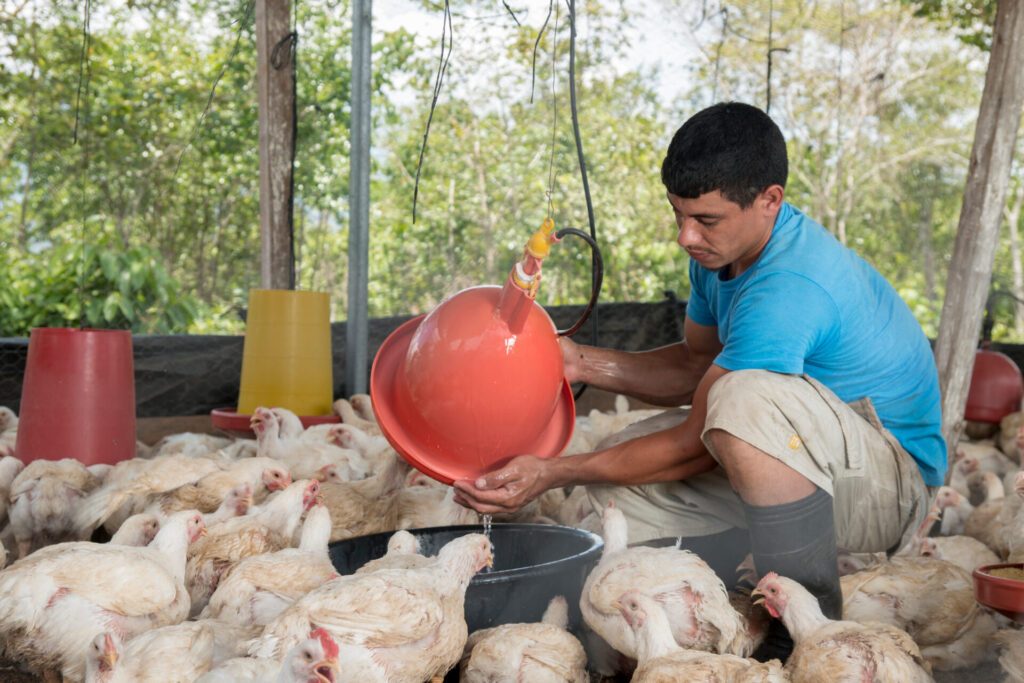Implementing stronger biosecurity to avoid disease spread to new areas

The World Organisation for Animal Health has analysed the current global situation, with the information shared by countries this past year through the World Animal Health Information System (WAHIS). The aggregated data show that African swine fever (ASF) and avian influenza, also known as bird flu, have spread more widely than in previous years, affecting a higher number of animals and reaching new areas across the globe. This noticeably led to devastating animal health and socioeconomic consequences. Livestock production, livelihoods, food security and even food prices have been heavily impacted.
Protecting livestock and wildlife from infectious diseases
Domestic and wild animals can mutually interact, whether directly or indirectly, through feed, waste or faeces, for instance. This interplay of populations can allow diseases to cross the species barriers and jump from one another. To prevent their dissemination, Veterinary Services have been promoting the importance of strict biosecurity measures. These are indeed essential to limit interactions between wildlife and livestock.
Looking at avian influenza, this year’s situation is unprecedented. “Over the past months, the avian influenza epidemic has continued to threaten animal health with a high number of cases reported and millions of poultry affected throughout the world”, highlights Dr Paula Caceres, Head of the World Animal Health Information and Analysis Department. Since October 2021, the beginning of the season for avian influenza, 47 countries reported close to 3,000 outbreaks in poultry. Measures to mitigate the spread have led to the culling of more than 80 million domestic birds.
Migratory wild birds, especially waterfowl, are natural hosts and reservoirs of avian influenza viruses, and can easily pass them onto other wild or domestic birds through direct or indirect contact such as through their feed. This year, important fatalities have been observed in wild birds, threatening biodiversity worldwide. For instance, in Israel, over 8,000 common cranes have died from avian influenza and hundreds of wild birds were found dead in the United Kingdom.
Since not much can be done to contain the disease in wild animals, the implementation of biosecurity measures in farms is crucial to avoiding the introduction of pathogens into poultry flocks. These measures do not only protect poultry, but also wildlife and its conservation. Relevant precautions notably include keeping domestic birds away from contact with wild birds, ensuring good hygiene in poultry housing and equipment, and being cautious when introducing new animals into the flock.
African swine fever has also much impacted the pig sector this year, affecting new areas. While it was historically first found in Africa and then spread to Asia and Europe, this pig disease has reached the Americas last summer, for the first time in almost 40 years. A few months later in December, North Macedonia reported the first occurrence of the disease in backyard pigs which most likely originated from the contact between domestic pigs and infected wild boar. The transmission of African swine fever at the livestock-wildlife interface seems to depend on the wild boar population and their interaction with low-biosecurity pig production systems. Yet, because there is no vaccine available for now, biosecurity remains the first line of defense against the disease.
Encouraging responsible human behaviours
Human activities can also be responsible for disseminating diseases. Travellers, hunters and even farmers can carry pathogens and introduce them into domestic and wild animal populations. When travelling, people sometimes unknowingly visit affected farms, or buy animal commodities that they will take back to their country of origin. When hunting in affected areas, it is possible to encounter wild species carrying infectious diseases. Thes activities can lead to people acquiring the pathogens on their boots, clothing or vehicles, and spreading diseases with their movements, from farm to farm, or into new countries. Implementing relevant precautions and adopting good hygiene practices is crucial, when in contact with animals. Cleaning clothing after visiting a farm and avoiding bringing back animal products from travels are all key measures to keep in mind.
The recent global trends of diseases, highlighted in the latest global animal health situation report, truly show the role of human activities in spreading African swine fever and avian influenza, amongst other diseases. To raise awareness on ways to address at-risk situations, the World Organisation for Animal Health provides a wide range of communication materials, on both African swine fever and avian influenza.

While other factors such as climate change and international trade can be considered, the spread of animal diseases can be contained by implementing strict biosecurity measures, along the entire livestock supply chain. Nevertheless, biosecurity must always be coupled with other measures: sensitisation amongst key stakeholders, increased surveillance efforts, and timely reporting of cases to Veterinary Authorities. Transparent sharing of animal health data is the cornerstone to enabling effective prevention and control of infectious animal diseases. In this regard, the efforts made by Members to maintain their level of disease monitoring and notification over the past year, despite the challenges linked to the Covid-19 pandemic, also need to be acknowledged.
Learn more
-
Report on the current animal health situation
-
African swine fever
-
Avian influenza
-
Video addressing biosecurity measures against avian influenza
